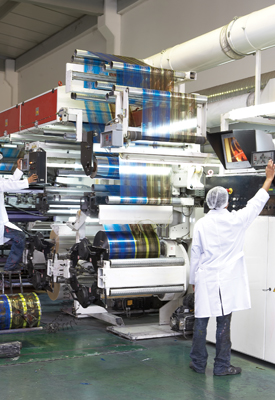Energy Conservation Strategies for Printers
 In general, printing facilities have similar processes and equipment; therefore, there are common energy conservation opportunities throughout the industry. Many processes, including press operation, paper handling, converting, binding, compressed air, humidification control, facility heating and cooling, drying, and emission control, require significant energy. Each of these processes presents an opportunity for implementing energy efficient technologies and energy saving procedures.
In general, printing facilities have similar processes and equipment; therefore, there are common energy conservation opportunities throughout the industry. Many processes, including press operation, paper handling, converting, binding, compressed air, humidification control, facility heating and cooling, drying, and emission control, require significant energy. Each of these processes presents an opportunity for implementing energy efficient technologies and energy saving procedures.
Technologies for Saving Energy
Some of the largest energy-using areas of a printing facility can include motors, thermal oxidizers, and dryers. Installing new technologies in these areas may help your facility lower your energy use and costs; however, they may be capital intensive.
Dryers and thermal oxidizers present the opportunity to recover waste heat. These opportunities may have high capital investments; however, printers recovering waste heat have estimated that their energy use reduction ranges from 8-42%, depending on the facility. Two of the ways recovered waste heat is being used is in an absorption refrigerator, which converts waste heat to useful refrigerated chiller rolls, and to preheat incoming dryer air.
Most heatset printers have a thermal oxidizer to burn VOCs to CO2 and water and meet air quality regulations, and dryers to dry solvent from inks, therefore curing ink to paper. When a thermal oxidizer is present in a printing facility, improvements, which increase energy efficiency, to the equipment may be possible. For example, replacing a recuperative thermal oxidizer with a more efficient regenerative thermal oxidizer can save energy. Additionally, if an older (circa 1980) regenerative thermal oxidizer is already in place energy savings can be realized by replacing it with a new, higher efficiency regenerative oxidizer. Other options include installing catalytic oxidizers on either a regenerative or a recuperative thermal oxidizer to lower the operating temperature from 1,600°F to 600°F. All these options reduce the amount of natural gas needed to operate the thermal oxidizer.
Compressed Air Improvements
Compressed air can be a significant user of electrical energy. With proper maintenance, this system can be optimized and reduce the electricity used by the compressor by 25%. Fixing leaks; reducing overall compressor discharge or system pressure; eliminating artificial demand and inappropriate uses; cooling intake air; and installing desiccant filters are all opportunities to optimize your compressed air system. Link to Compressed air bmp
Motor and Pump System Efficiency
Facilities that utilize motors and pumps extensively can save energy by installing high efficiency motors and variable frequency drives, eliminating voltage unbalance, and properly maintaining equipment. Link to motors bmp.
Don’t forget to check with your utility company to see if they offer rebates for upgrading your equipment or making other strides in energy efficiency.
Lighting and Facility Improvements
Improvements to your facility’s lighting as well as HVAC systems are often inexpensive and rebated by your utility. Two fairly easy, low-cost ways to reduce energy use are to install high efficiency LED lighting fixtures and lower the thermostat temperature. Using radiant heat in warehouses or other storage areas can heat people and reduce the volume of air heated in areas that are sparingly used. Finally, installing programmable thermostats in your facility can prevent inefficient temperature fluctuations and reduce the temperature when the facility is unoccupied.